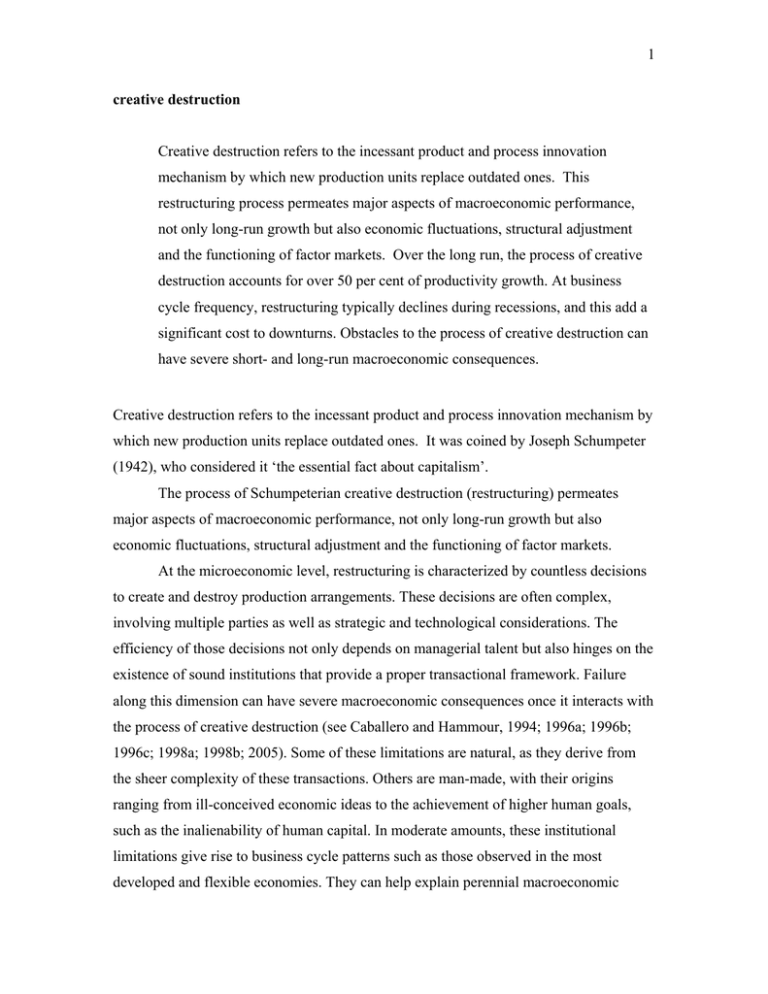Creative Destruction
advertisement

1 creative destruction Creative destruction refers to the incessant product and process innovation mechanism by which new production units replace outdated ones. This restructuring process permeates major aspects of macroeconomic performance, not only long-run growth but also economic fluctuations, structural adjustment and the functioning of factor markets. Over the long run, the process of creative destruction accounts for over 50 per cent of productivity growth. At business cycle frequency, restructuring typically declines during recessions, and this add a significant cost to downturns. Obstacles to the process of creative destruction can have severe short- and long-run macroeconomic consequences. Creative destruction refers to the incessant product and process innovation mechanism by which new production units replace outdated ones. It was coined by Joseph Schumpeter (1942), who considered it ‘the essential fact about capitalism’. The process of Schumpeterian creative destruction (restructuring) permeates major aspects of macroeconomic performance, not only long-run growth but also economic fluctuations, structural adjustment and the functioning of factor markets. At the microeconomic level, restructuring is characterized by countless decisions to create and destroy production arrangements. These decisions are often complex, involving multiple parties as well as strategic and technological considerations. The efficiency of those decisions not only depends on managerial talent but also hinges on the existence of sound institutions that provide a proper transactional framework. Failure along this dimension can have severe macroeconomic consequences once it interacts with the process of creative destruction (see Caballero and Hammour, 1994; 1996a; 1996b; 1996c; 1998a; 1998b; 2005). Some of these limitations are natural, as they derive from the sheer complexity of these transactions. Others are man-made, with their origins ranging from ill-conceived economic ideas to the achievement of higher human goals, such as the inalienability of human capital. In moderate amounts, these institutional limitations give rise to business cycle patterns such as those observed in the most developed and flexible economies. They can help explain perennial macroeconomic 2 issues such as the cyclical behaviour of unemployment, investment, and wages. In higher doses, by limiting the economy’s ability to tap new technological opportunities and adapt to a changing environment, institutional failure can result in dysfunctional factor markets, resource misallocation, economic stagnation, and exposure to deep crises. Given the nature of this short piece, I will skip any discussion of models, and refer the reader to Caballero (2006) for a review of the models behind the previous paragraph, and to Aghion and Howitt (1998) for an exhaustive survey of Schumpeterian growth models. Instead, I focus on reviewing recent empirical evidence on different aspects of the process of creative destruction. Recent evidence on the pace of creative destruction There is abundant recent empirical evidence supporting the Schumpeterian view that the process of creative destruction is a major phenomenon at the core of economic growth in market economies. The most commonly used empirical proxies for the intensity of the process of creative destruction are those of factor reallocation and, in particular, job flows. Davis, Haltiwanger and Schuh (1996) (henceforth DHS) offered the clearest peek into this process by documenting and characterizing the large magnitude of job flows within US manufacturing. They defined job creation (destruction) as the positive (negative) net employment change at the establishment level from one period to the next. Using these definitions, they concluded that over ten per cent of the jobs that exist at any point in time did not exist a year before or will not exist a year later. That is, over ten per cent of existing jobs are destroyed each year and about the same amount is created within the same year. Following the work by DHS for the United States, many authors have constructed more or less comparable measures of job flows for a variety of countries and episodes. Although there are important differences across them, there are some common findings. In particular, job creation and destruction flows are large, ongoing, and persistent. Moreover, most job flows take place within rather than between narrowly defined sectors of the economy. Given the magnitude of these flows and that they take place mostly within narrowly defined sectors, the presumption is strong that they are an integral part of the 3 process by which an economy upgrades its technology. Foster, Haltiwanger and Krizan (2001) provide empirical support for this presumption. They decompose changes in industry-level productivity into within-plant and reallocation (between-plant) components, and conclude that the latter -- the most closely related to the creative destruction component -- accounts for over 50 per cent of the ten-year productivity growth in the US manufacturing sector between 1977 and 1987. Moreover, in further decompositions they document that entry and exit account for half of this contribution: exiting plants have lower productivity than continuing plants. New plants, on the other hand, experience a learning and selection period through which they gradually catch up with incumbents. Other studies of US manufacturing based on somewhat different methodologies (see Baily, Hulten and Campbell, 1992; Bartelsman and Dhrymes, 1994) concur with the conclusion that reallocation accounts for a major component of withinindustry productivity growth. Bartelsman, Haltwanger and Scarpetta (2004) provide further evidence along these lines for a sample of 24 countries and two-digit industries over the 1990s. Recent evidence on the cyclical features of creative destruction At the business cycle frequency, sharp liquidations (rises in job destruction) constitute the most noted impact of contractions on creative destruction. In contrast, job creation is substantially less volatile and mildly pro-cyclical. There is an extensive literature that, extrapolating from the spikes in liquidations (recently measured in job flows but long noticed in other contexts), finds that recessions are times of increased reallocation. In fact, this has been a source of controversy among economists at least since the preKeynesian ‘liquidationist’ theses of such economists as Hayek, Schumpeter, and Robbins. These economists saw in the process of liquidation and reallocation of factors of production the main function of recessions. In the words of Schumpeter (1934, p. 16): ‘depressions are not simply evils, which we might attempt to suppress, but ... forms of something which has to be done, namely, adjustment to ... change.’ In Caballero and Hammour (2005) we turned the liquidationist view upside down. While we sided with Schumpeter and others on the view that increasing the pace of 4 restructuring of the economy is likely to be beneficial, we provided evidence that, contrary to conventional wisdom, restructuring falls rather than rises during contractions. Since the rise in liquidations during recessions is not accompanied by a contemporaneous increase in creation, implicit in the increased-reallocation view is the idea that increased destruction is followed by a surge in creation during the recovery phase of the cyclical downturn. This presumption is the only possible outcome in a representative firm economy, as the representative firm must replace each job it destroys during a recession by creating a new job during the ensuing recovery. However, once one considers a heterogeneous productive structure that experiences ongoing creative destruction, other scenarios are possible. The cumulative effect of a recession on overall restructuring may be positive, zero, or even negative, depending not only on how the economy contracts but also on how it recovers. Thus, the relation between recessions and economic restructuring requires one to examine the effect of a recession on aggregate separations not only at impact, but cumulatively throughout the recession-recovery episode. We explored this issue using quarterly US manufacturing gross job flows and employment data for the 1972-93 period, and found that, along the recovery path, job destruction declines and falls below average for a significant amount of time, more than offsetting its initial peak. On the other hand, job creation recovers, but it does not exceed its average level by any significant extent to offset its initial decline. As a result, our evidence indicates that, on average, recessions depress restructuring. Similarly, in Caballero and Hammour (2001) we approached the question of the pace of restructuring over the cycle from the perspective of corporate assets. Studying the aggregate patterns of merger and acquisition (M&A) activity and its institutional underpinnings, we reached a conclusion that also amounts to a rejection of the liquidationist perspective. Essentially, a liquidationist perspective in this context would consider fire sales during sharp liquidity contractions as the occasion for intense restructuring of corporate assets. The evidence points, on the contrary, to briskly expansionary periods characterized by high stock market valuations and abundant liquidity as the occasion for intense M&A activity. Recent evidence on institutional impediments to creative destruction and their cost 5 For all practical purposes, some product or process innovation is taking place at every instant in time. Absent obstacles to adjustment, continuous innovation would entail infinite rates of restructuring. What are these obstacles to adjustment? The bulk of it is technological -- adjustment consumes resources -- but (over-?) regulation and other manmade institutional impediments are also a source of depressed restructuring. While few economists would object to the hypothesis that labour market regulation hinders the process of creative destruction, its empirical support is limited. In Caballero et al. (2004) we revisited this hypothesis using a sectoral panel for 60 countries. We found that job security provisions -- measured by variables such as grounds for dismissal protection, protection regarding dismissal procedures, notice and severance payments, and protection of employment in the constitution -- hamper the creative destruction process, especially in countries where regulations are likely to be enforced. Moving from the 20th to the 80th percentile in job security cuts the annual speed of adjustment to shocks by a third. By impairing worker movements from less to more productive units, effective labour protection reduces aggregate output and slows down economic growth. We estimated that moving from the 20th to the 80th percentile of job security lowers annual productivity growth by as much as 1.7 per cent. Similarly, the idea that well-functioning financial institutions and markets are important factors behind economic growth is an old one. The process of creative destruction is likely to be a chief factor behind this link. In Caballero, Hoshi and Kashyap (2006) we analysed the decade-long Japanese slowdown of the 1990s and early 2000s. The starting point of our analysis is the well-known observation that many large Japanese banks would have been out of business had regulators forced them to recognize all their loan losses. Because of this, the banks kept many zombie firms alive by rolling over loans that they knew would not be collected (evergreening). Thus, the normal competitive outcome whereby the zombies would shed workers and lose market share was thwarted. Using an extensive data set, we documented that roughly 30 per cent of firms were on life support from the banks in 2002 and about 15 per cent of assets resided in these firms. The main idea in our article is that the counterpart to the congestion created by the zombies is a reduction in profits for potential and more productive 6 entrants, which discourages their entry. We found clear evidence of such a pattern in firm-level data and of the corresponding reduced restructuring in sectoral data. Bertrand, Schoar and Thesmar (2004) further drive home the point that problems in the banking sector can have grave consequences for the health of the restructuring process. They use a differences-in-differences approach on firm-level data for the period 1977-99 to analyse the impact of the banking reforms of the mid-1980s on firm and bank behaviour. These reforms eliminated government interference in bank lending decisions, eliminated subsidized bank loans, and allowed French banks to compete more freely in the credit market. They find that, after the reforms, firms’ exit rates and asset reallocation rise, and are more correlated with performances. International competition is an important source of creative destruction. Trefler (2004) concludes that there are significant productivity and reallocation effects from trade openness, even in industrialized economies. To reach this conclusion, Trefler takes advantage of the Canada-US. Free Trade Agreement (FTA) to study the effects of a reciprocal trade agreement on Canada. He finds that, for industries that experienced the deepest Canadian tariff reductions, the contraction of low-productivity plants reduced employment by 12 per cent while raising industry-level labour productivity by 15 per cent. Moreover, he finds that at least half of this increase is related to exit and/or contraction of low-productivity plants. Finally, for industries that experienced the largest US tariff reductions, plant-level labour productivity soared by 14 per cent. Consistent with this evidence, Bernard, Jensen and Schott (2006) find that in the United States productivity growth is fastest in industries where trade costs (barriers) have declined the most. Domestic deregulation of goods markets can have similar effects. For example, Olley and Pakes (1996) find that deregulation in the US telecommunications industry increased productivity predominantly through factor reallocation toward more productive plants rather than through intra-plant productivity gains. More broadly, Klapper, Laeven and Rajan (2004) study the effect of entry regulation on firm behaviour in a sample including firm-level data from countries of western and eastern Europe. Their findings support the notion that regulation affects entry: ‘naturally high-entry’ industries have relatively lower entry in countries that have higher entry regulations. Moreover, both the 7 growth rate and share of high-entry industries are depressed in countries with more stringent barriers to entry. Finally, Fishman and Sarria-Allende (2004) extend the Klapper, Laeven and Rajan study to countries outside Europe and include both industryand firm-level data from the UNIDO and WorldScope databases, and reach similar conclusions. Final remarks Evidence and models coincide in their conclusion that the process of creative destruction is an integral part of economic growth and fluctuations. Obstacles to this process can have severe short- and long-run macroeconomic consequences. Ricardo J. Caballero Bibliography Aghion, P. and Howitt, P. 1998. Endogenous Growth Theory. Cambridge, MA: MIT Press. Baily, N., Hulten, C. and Campbell, D. 1992. Productivity dynamics in manufacturing establishments. In Brookings Papers on Economic Activity: Microeconomics, ed. M. Baily and C. Winston. Washington, DC: Brookings Institution Bartelsman, E. and Dhrymes, P. 1994. Productivity dynamics: U.S. manufacturing plants, 1972–1986. Finance and Economics Discussion Series No. 94-1. Washington, DC: Board of Governors, Federal Reserve System. Bartelsman, E., Haltiwanger, J. and Scarpetta, S. 2004. Microeconomic evidence of creative destruction in industrial and developing countries. Mimeo, University of Maryland. Bernard, A., Jensen, J. and Schott, P. 2004. Survival of the best fit: exposure to low-wage countries and the (uneven) growth of U.S. manufacturing plants. Journal of International Economics 68, 219–37. Bertrand, M., Schoar, A. and Thesmar, D. 2004. Banking deregulation and industry structure: evidence from the French banking reforms of 1985. Discussion Paper No. 4488. London: Centre for Economic Policy Research. 8 Caballero, R. 2006. The Macroeconomics of Specificity and Restructuring. Yrjo Jahnsson Lectures. Cambridge, MA: MIT Press. Caballero, R. and Hammour, M. 1994. The cleansing effect of recessions. American Economic Review 84, 1350-68. Caballero, R. and Hammour, M. 1996a. The fundamental transformation in macroeconomics. American Economic Review 86(2), 181–6. Caballero, R. and Hammour, M. 1996b. On the timing and efficiency of creative destruction. Quarterly Journal of Economics 111, 805–52. Caballero, R. and Hammour, M. 1996c. On the ills of adjustment. Journal of Development. Economics 51, 161–92. Caballero, R. and Hammour, M. 1998a. The macroeconomics of specificity. Journal of Political Economy 106, 724–67. Caballero, R. and Hammour, M. 1998b. Jobless growth: appropriability, factor substitution and unemployment. Carnegie-Rochester Conference Series on Public Policy 48, 51–94. Caballero, R. and Hammour, M. 2001. Institutions, restructuring, and macroeconomic performance. In Advances in Macroeconomic Theory, ed. J. Dreze. New York: Palgrave Macmillan. Caballero, R. and Hammour, M. 2005. The cost of recessions revisited: a reverseliquidationist view. Review of Economic Studies 72, 313–41. Caballero, R., Hoshi, T. and Kashyap, A. 2006. Zombie lending and depressed restructuring in Japan. Working Paper No. 12129. Cambridge, MA: NBER. Caballero, R., Cowan, K., Engel, E. and Micco, A. 2004. Effective labor regulation and microeconomic flexibility. Mimeo, MIT. Davis, S., Haltiwanger, J. and Schuh, S. 1996. Job Creation and Destruction. Cambridge, MA: MIT Press. Fishman, R. and Sarria-Allende, V. 2004. Regulation of entry and the distortion of industrial organization. Working Paper No. 10929. Cambridge, MA: NBER. Foster, L., Haltiwanger, J. and Krizan, C. 2001. Aggregate productivity growth: lessons from microeconomic evidence. In New Developments in Productivity Analysis, ed. E. Dean, M. Harper and C. Hulten. Chicago: University of Chicago Press. 9 Klapper, L., Laeven, L. and Rajan, R. 2004. Business environment and firm entry: evidence from international data. Working Paper No. 10380. Cambridge, MA: NBER. Olley, S. and Pakes, A. 1996. The dynamics of productivity in the telecommunications equipment industry. Econometrica 64, 1263–98. Schumpeter, J. 1934. Depressions. In Economics of the Recovery Program, ed. D. Brown et al. New York: McGraw-Hill. Schumpeter, J. 1942. Capitalism, Socialism, and Democracy. New York: Harper & Bros. Trefler, D. 2004. The long and short of the Canada–U.S. Free Trade Agreement. American Economic Review 94, 870–95.

